
views
- Sweep or vacuum your vinyl plank floors to clean dirt and debris before polishing them. Work wax remover into the floor if there’s old finish on the planks.
- Polish your floors with an pH neutral vinyl cleaner and mop going in the direction of the grain. Alternatively, use diluted vinegar or rubbing alcohol to make your floors shine.
- Wipe your floor with a damp cloth or mop after using cleaner to remove residue.
Cleaning & Polishing Vinyl Floors

Vacuum or sweep your flooring. Use a soft-bristle broom or dust mop to sweep all the dirt and dust off of your floor. If you’d rather vacuum, just turn off the beater brush so you don’t scratch your luxury vinyl planks while you’re cleaning your floors. Sweeping or vacuuming removes small pieces of dirt, sand, and rocks that could leave scratches on the floor and ruin the finish. If you can’t turn off the beater brush on your vacuum, then use a brush or hose attachment to clean your floors instead.
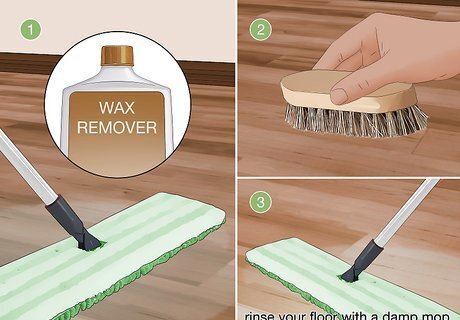
Use wax remover to strip floors if they have an old cloudy finish. While it’s not normal for luxury vinyl planks to have a finish, your floors may have them if you’ve used wax or “quick shine” products in the past. Wet a sponge mop with a wax remover that’s specifically made for vinyl flooring. Work the wax remover over a small part of your floor, and let it sit to strip the wax. Then, gently scrub the spot with a brush or electric scrubber to clean off the finish. Rinse your floor with a damp mop and let it dry completely. For a homemade wax remover, mix ⁄2–1 cup (120–240 ml) of ammonia in 1 gallon (3.8 L) of warm water. Test the wax remover in an inconspicuous spot first to make sure it works on your floors. Follow the directions on the wax remover’s label since they may vary slightly.
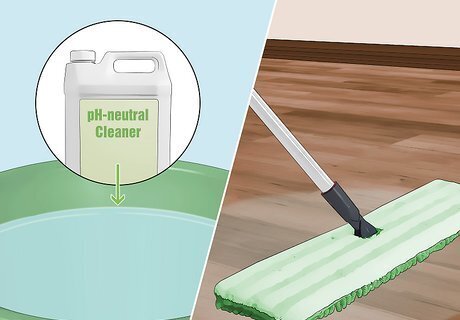
Mop a pH-neutral cleaner onto your floors to restore their shine. Follow the instructions on the cleaner’s package to find the proper amount to mix with warm water. Wet a sponge mop with the cleaner and wring out the excess. Follow the grain direction on the luxury vinyl planks as you mop to get dirt and dust deep in the crevices that make your floors look dull. Follow up with a mop damp with clean water to rinse the cleaner off. Avoid putting undiluted acidic or abrasive cleaners on your floors since they could damage your floors or leave a haze on the surface. Make sure that the mop isn’t dripping wet and that liquid doesn’t puddle up on the floor since it could cause damage to your floors.
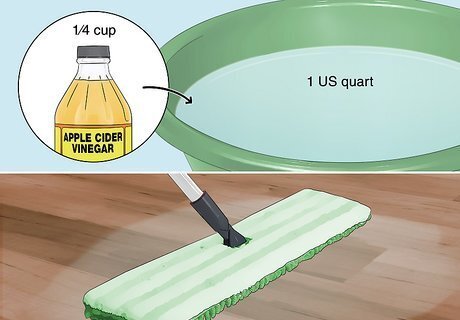
Scrub your floors with an apple cider vinegar solution for a natural polish. Mix ⁄4 cup (59 ml) of apple cider vinegar with about 1 US quart (0.95 L) of warm water. Wet a mop in the solution and lightly scrub your floors in the same direction that the planks run. Rinse your mop out with hot water as you spread the cleaning solution across the floor. Apple cider vinegar strips the dirt and debris stuck in the wear layer of your vinyl planks so their original shine shows through again. Use distilled white vinegar instead if you want to disinfect your floors at the same time. Add a few drops of baby oil or Jojoba oil to the vinegar solution to spread a thin, shiny coating over your floors.
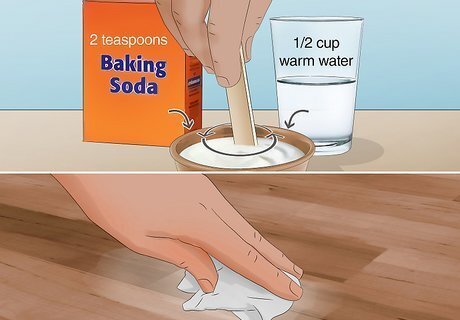
Use a baking soda paste to scrub away stains and dull spots. Mix equal parts water and baking soda so it forms a thick paste. Dab the paste with a damp microfiber cloth onto any stains or marks scuffing up your vinyl floors. Gently scrub the paste around the edges of the stain and work toward the center to remove it and make the vinyl planks shine again. Then, use a clean damp cloth or mop to wipe up the baking soda. Baking soda works great for getting rid of cloudy marks or stains left over from food or drinks. If you still notice the stain, try applying the baking soda paste and scrubbing it again.

Buff scuff marks out with a damp melamine sponge. If you notice black scuffs marking up your floor in high-traffic areas, wet a melamine sponge and wring out all the water. Gently scrub at the scuff mark to lift it off your floors and make them glossy again. Avoid scrubbing with an abrasive sponge or bristle brush since it weakens the wear layer of the vinyl that protects your flooring.

Try diluted rubbing alcohol to get rid of the toughest marks on your floor. Mix equal parts of rubbing alcohol and warm water in a container. Either use a sponge mop or a microfiber cloth to spread the alcohol solution over the mark on your floor. Then, wipe the area clean with a damp cloth. If the mark still doesn’t come up, wet the corner of a clean cloth with undiluted rubbing alcohol and gently wipe the stain. Rinse the alcohol off when you’re finished with a damp cloth. Rubbing alcohol works best for oily stains from nail polish, ink, or cosmetics.
Maintaining Vinyl Plank Flooring

Sweep or vacuum dirt regularly. Whenever you notice dirt, dust, or debris, clean your floors with a broom, dust mop, or vacuum. Check your floors daily to see if they’re dirty and need cleaning; otherwise, make it a habit to clean your floors at least once a week. Avoid using the beater brush on your vacuum since you could scratch the finish off your vinyl planks.

Place doormats at the entrances. Put a doormat on the inside and outside of each doorway. Wipe off your shoes every time before walking on your floors so you’re less likely to track dirt or debris inside that could make your floors dull or scratch the surface. Avoid using mats that have rubber backing since they could potentially stain your vinyl floors.

Close your blinds to protect your floor from sunlight. UV rays from the sun can cause discoloration and damage to your floors after prolonged exposure, so shut your blinds or shades during the brightest times of the day.

Use floor protectors under furniture. Put a protective floor mat down under rolling chairs or furniture that you move often so you don’t leave marks on your floor. Alternatively, attach felt furniture pads to the bottom of heavy furniture so it doesn’t scrape against the vinyl planks any time you move them. Replace the felt pads when they look dirty or covered in debris since they could start scratching your floor.
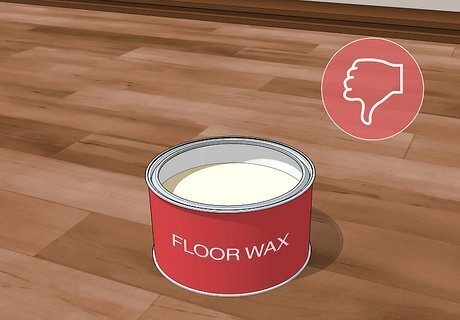
Avoid waxing your floors. Luxury vinyl plank floors already have a protective coating built into them, so they don’t require an additional finish. Layers of wax can also start looking cloudy or hazy over time, so it’s best to just clean your vinyl floors regularly to keep them shiny and sparkling.















Comments
0 comment